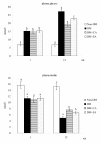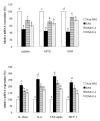Anti-inflammatory and anti-coagulatory activities of caffeic acid and ellagic acid in cardiac tissue of diabetic mice
- PMID: 19678956
- PMCID: PMC2736962
- DOI: 10.1186/1743-7075-6-33
Anti-inflammatory and anti-coagulatory activities of caffeic acid and ellagic acid in cardiac tissue of diabetic mice
Abstract
Background: Caffeic acid (CA) and ellagic acid (EA) are phenolic acids naturally occurring in many plant foods. Cardiac protective effects of these compounds against dyslipidemia, hypercoagulability, oxidative stress and inflammation in diabetic mice were examined.
Methods: Diabetic mice were divided into three groups (15 mice per group): diabetic mice with normal diet, 2% CA treatment, or 2% EA treatment. One group of non-diabetic mice with normal diet was used for comparison. After 12 weeks supplement, mice were sacrificed, and the variation of biomarkers for hypercoagulability, oxidative stress and inflammation in cardiac tissue of diabetic mice were measured.
Results: The intake of CA or EA significantly increased cardiac content of these compounds, alleviated body weight loss, elevated plasma insulin and decreased plasma glucose levels in diabetic mice (p < 0.05). These treatments also significantly enhanced plasma antithrombin-III and protein C activities (p < 0.05); and decreased triglyceride content in cardiac tissue and plasma (p < 0.05), in which the hypolipidemic effects of EA were significantly greater than that of CA (p < 0.05). CA or EA significantly lowered cardiac levels of malondialdehyde, reactive oxygen species, interleukin (IL)-beta, IL-6, tumor necrosis factor (TNF)-alpha and monocyte chemoattractant protein (MCP)-1 (p < 0.05); and retained cardiac activity of glutathione peroxidase (GPX), superoxide dismutase (SOD) and catalase (p < 0.05). These compounds also significantly up-regulated cardiac mRNA expression of GPX1, SOD and catalase; and down-regulated IL-1beta, IL-6, TNF-alpha and MCP-1 mRNA expression in diabetic mice (p < 0.05).
Conclusion: These results support that CA and EA could provide triglyceride-lowering, anti-coagulatory, anti-oxidative, and anti-inflammatory protection in cardiac tissue of diabetic mice. Thus, the supplement of these agents might be helpful for the prevention or attenuation of diabetic cardiomyopathy.
Figures


Similar articles
-
Anti-glycative and anti-inflammatory effects of caffeic acid and ellagic acid in kidney of diabetic mice.Mol Nutr Food Res. 2010 Mar;54(3):388-95. doi: 10.1002/mnfr.200900087. Mol Nutr Food Res. 2010. PMID: 19885845
-
Preventive effects of ellagic acid against doxorubicin-induced cardio-toxicity in mice.Cardiovasc Toxicol. 2013 Sep;13(3):185-93. doi: 10.1007/s12012-013-9197-z. Cardiovasc Toxicol. 2013. PMID: 23322372
-
Asiatic acid and maslinic acid protected heart via anti-glycative and anti-coagulatory activities in diabetic mice.Food Funct. 2015 Sep;6(9):2967-74. doi: 10.1039/c5fo00549c. Food Funct. 2015. PMID: 26190771
-
Anti-Diabetic Effects of Madecassic Acid and Rotundic Acid.Nutrients. 2015 Dec 2;7(12):10065-75. doi: 10.3390/nu7125512. Nutrients. 2015. PMID: 26633490 Free PMC article.
-
An overview on the protective effects of ellagic acid against heavy metals, drugs, and chemicals.Food Sci Nutr. 2023 Sep 26;11(12):7469-7484. doi: 10.1002/fsn3.3704. eCollection 2023 Dec. Food Sci Nutr. 2023. PMID: 38107104 Free PMC article. Review.
Cited by
-
Antioxidant and Antihyperlipidemic Effects of Campomanesia adamantium O. Berg Root.Oxid Med Cell Longev. 2016;2016:7910340. doi: 10.1155/2016/7910340. Epub 2016 Jul 14. Oxid Med Cell Longev. 2016. PMID: 27493705 Free PMC article.
-
Ellagic acid in suppressing in vivo and in vitro oxidative stresses.Mol Cell Biochem. 2018 Nov;448(1-2):27-41. doi: 10.1007/s11010-018-3310-3. Epub 2018 Jan 31. Mol Cell Biochem. 2018. PMID: 29388153 Review.
-
Effects of Dapagliflozin on Myocardial Gene Expression in BTBR Mice with Type 2 Diabetes.Cardiovasc Drugs Ther. 2025 Feb;39(1):43-61. doi: 10.1007/s10557-023-07517-1. Epub 2023 Nov 2. Cardiovasc Drugs Ther. 2025. PMID: 37914900
-
New Mesoporous Silica Materials Loaded with Polyphenols: Caffeic Acid, Ferulic Acid and p-Coumaric Acid as Dietary Supplements for Oral Administration.Materials (Basel). 2022 Nov 11;15(22):7982. doi: 10.3390/ma15227982. Materials (Basel). 2022. PMID: 36431468 Free PMC article.
-
Unveiling the Dual Nature of Heavy Metals: Stressors and Promoters of Phenolic Compound Biosynthesis in Basilicum polystachyon (L.) Moench In Vitro.Plants (Basel). 2023 Dec 28;13(1):98. doi: 10.3390/plants13010098. Plants (Basel). 2023. PMID: 38202406 Free PMC article.
References
-
- Sowers JR, Epstein M, Frohlich ED. Diabetes, hypertension and cardiovascular disease: an update. Hypertension. 2001;37:1053–1059. - PubMed
-
- Zhou G, Li X, Hein DW, Xiang X, Marshall JP, Prabhu SD, Cai L. Metallothionein suppresses angiotensin II-induced nicotinamide adenine dinucleotide phosphate oxidase activation, nitrosative stress, apoptosis, and pathological remodeling in the diabetic heart. J Am Coll Cardio. 2008;52:655–666. doi: 10.1016/j.jacc.2008.05.019. - DOI - PubMed
LinkOut - more resources
Full Text Sources
Other Literature Sources
Miscellaneous

